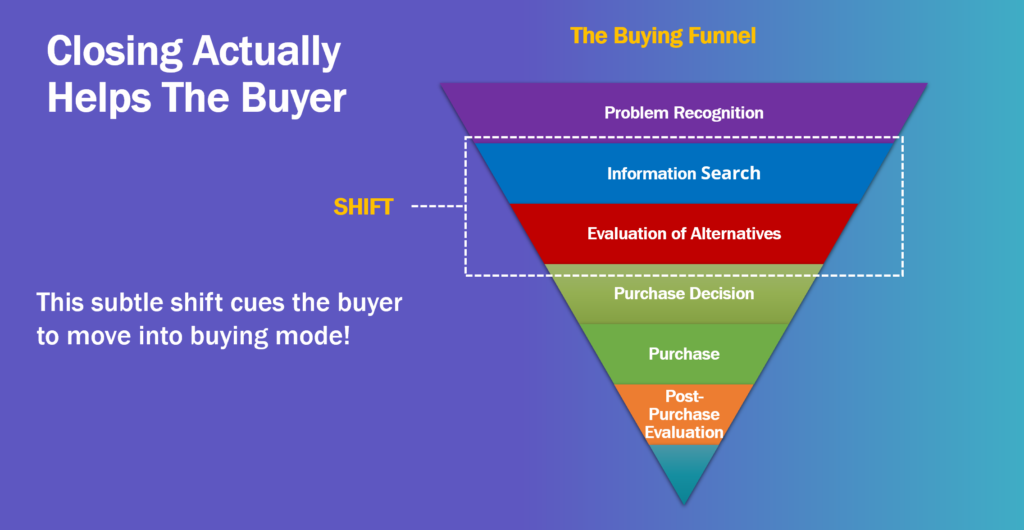3 Tips to Get Deals Moving NOW (So You Hit Quota!) [Webinar Recording]
3 Tips to Get Deals Moving NOW (So You Hit Quota!)
[Video Recording]
[Video Recording]

Congratulations! You got the big boss to attend your call. Now let’s make sure you’ve got enough executive presence to impress them.
Senior executives by definition have less time and patience than any other decision-maker. No big surprise. But you might be surprised to learn they probably also have less knowledge than anyone else on your call. They’ll also have different expectations. Here are some tips for making sure you’re ready to make your shortlist in just one call and understand how to show executive presence.
Create and send an agenda, be sure the invite and link/location are clear and sent well ahead of time, and start the call with background and introductions.
Even if you’ve been talking with this company for months and this is call #5, you should assume the executive knows exactly none of this history. Help them orient themselves quickly to this meeting by briefly explaining:
(If you’re new to Factor 8, that stands for “So What’s In It For Them”). That means that even if your goal of the call is to get a commitment, you must communicate it in SWIIFT℠ language, like helping them decide to go/no go with the project or if you are a viable solution to their needs (see, it’s about THEIR needs, not your sale).
Let’s pause here for an example. Let’s say you’ve been evaluating training vendors to help scale your sales operation. Your VP of Sales boss has joined the call. The vendor (me at Factor 8) says:
Welcome, everyone! Great to meet you, Mr. Big Boss. Let me start with a quick background. My name is Lauren Bailey, the founder of Factor 8, a rep and manager training provider in the virtual sales space. ABC company is evaluating us to help you with your rapid-scale goal – specifically more onboarding and upskilling for your SDRs, AEs, and managers. This is our third meeting with your team, and today our goal is to answer all of your questions about how it might look should we work together – so you and the team can decide if we move forward. Does that work?
Obviously, you’ll use your own words here, but I do encourage you to plan this out (to be clear, I rewrote this three times!). Script, bullets, whatever works for you, but it’s critical to start clearly and strongly. OK, back to the list.
Most execs get a quick read and will instantly have questions to accompany their impressions. As a rule after a strong intro, I ask what they want to accomplish and if they have any initial questions. Then I arrange my meeting to hit their needs in priority order. Try it, I bet 9 out of 10 times they’re sitting on something they want, and until it comes off their chest they’re only half-listening to you.
BONUS: every other vendor launches into their regular dog and pony show. Letting them talk first and systematically hitting all of their requests instantly differentiates you (and clues you into so much!)
Executives bounce from meeting to meeting with a huge range of subjects and almost NEVER have the time to pre-read the agenda, email, website, or proposal. So assume nothing! Tell them the category, the goal, or the situation before filling in the details. If you start with the features, the end result, or the specifics they’ll just stop listening and assume YOU are the disorganized one.
Truth: Even my husband has learned to communicate with me this way. It sounds like, “Honey? Got a sec? OK, it’s about our kids’ lunches…”
This is especially important because we work together too, so our “meetings” together could range from commission structures to date nights. 😀
Go and edit your questions AND your stock answers to cut your words by half. Give a short and decisive answer and then ask if they want an example or more detail.
I don’t mean you should ignore everyone else on the call. In fact, do all you can to make them look very good in front of the boss. But if 2 people ask a question at once, the executive always wins. Check in with them individually to see if they like your direction, agree with the summary you just gave, or have anything to add, etc. They’ve earned their position and although they may not demand special treatment, they’ve probably gotten used to receiving a little.
Even if your answer is, “I don’t know,” say it with a strong tone and volume, promise to get back with them, and then move on. Sit up straight, frame your chest and shoulders in your video shot (if using), and don’t get over-excited. Hemming and hawing, telling long stories, BS-ing, and going in circles with lots of extra words will guarantee you lose.
All of these tips combined will help you project yourself as an equal because executives make fast assumptions about your company and your solution based on how you present yourself in the meeting. It’s OK if you’re 22 and new, just as long as you come off as organized and confident.
The best thing you can do now is to go back and listen to or watch several recent meetings with this checklist. Give yourself an executive presence score out of 10 and take a few actions on what you could level up.
Now knock ‘em dead!

Everyone loves to talk about how many calls it takes to get someone on the phone (me included), but not enough of us talk about how to KEEP them on the phone!
If you’re making cold calls or even cold-ish calls, and you FINALLY get someone to answer, you feel a bit like…

Now, don’t blow it. The number one mistake at this stage is to begin a full-on sales vomit.
We give the elevator pitch,
We give the value prop,
We ask a question,
Then we answer the question for them…
All the while we’re still actually tuning in to the fact we are getting a chance to do our jobs and someone is on live with us. And as soon as our brains catch up with our mouths, the prospect is saying:
“This isn’t a good time.” or “I’m not actually in the market right now.”
We call this an “Early Dismissal” as opposed to an objection (where they have a relevant reason or question based on our actual offering). You might call it, “getting blown off, rejected, turned down, shut down”, or “blown out” if you’re a friend from the UK.
So what do you do when you’re getting shut down in the first 30 seconds of the call? We got you.
The best way to stop the sales word vomit is to never start it. Get a SWIIFT℠ intro down pat. This is a 10-second intro that is designed to get prospects talking FAST.
Lots of folks think their elevator speech (what I do and why you care) is the same as their intro and that’s exactly wrong. Save this for when they say, “Wait, who are you with again?” Now they’re listening! Another smart reason to save it: Your intro should be as much about them as possible and as little about you as possible. This way we don’t sound like desperate salespeople.
Desperate salespeople consistently get shut down with early dismissals.
If you sound like their neighbor or like they’re lucky to even be talking to you, you’ll have more luck keeping them on! Again, the key to this is a go-to introduction and practice. Yes, write it down if you need to for the first few calls. Then ditch it because reading it sounds neither conversational nor confident!
We teach 2 ways to overcome the dismissal and neither is anywhere close to how we overcome an objection. When we overcome objections, we dig into the why and address concerns. An early dismissal is not based on fact. It’s another way to say:
“Leave me alone, I’m busy.”
“I don’t like salespeople.”
“I can’t deal right now.”
So don’t dig in, drive around! The key to keeping prospects on the phone is to get them talking! Do this by bringing up a random subject or even digging into their BS excuse with a question.
For example:
Dismissal: “I’m not the right person.”
Rep: “So how are things going over there?” (unrelated question), or
Rep: “So there are more folks in your department?”
The key is to not stop! Now ask another question. And another. And before you know it, you’re getting the information out of them you called to get!
Second key: Prevent sounding defensive at all costs! Here’s an example of what sometimes happens that doesn’t work:
Dismissal: “I’m not the right person.”
Rep: “So, you aren’t interested in saving money?”
Prospect: “No you little turd and now I will never buy from you ever.”
Get the difference? I’m not saying to strong-arm, I’m telling you to deaf ear. Keep it sweet and light and go right on past them with another question and before they even realize it, you’ve gotten two qualifying questions answered and the name of the right person to call (or a better time to call them).
It doesn’t work every time, but we see a good 70% plus success rate!

Are you thinking, “Should I leave a voicemail? Nobody ever calls back! Am I doing something wrong? Why aren’t people calling me back? Can I leave a better voicemail?”
Don’t worry, you’re not alone… and you aren’t wrong.
A good 90% of our outbound calls end in voicemails and less than 3% are actually returned. Oh boy, math time. That means up to 225 voicemails left every week if I’m making 50 calls a day. And only 7-8 potential clients calling me back. More bad news: That’s because your voicemails are probably bad (sorry).
Frankly, most voicemails aren’t great. In fact, voicemails are the one time I advocate for a script. Actually, 4 scripts. After 15 years of teaching phone sales, we’ve found 4 voicemails that consistently get more calls back. We’re talking, double to triple more. Ready for the math? That means 14-23 calls back in a week instead of 8. Dude, 14 more conversations every week! That’s like getting a bonus day of selling time every week, for only the cost of changing up a voicemail. Yup, it’s literally that easy.
WATCH: How To Leave A Sales Voicemail That Gets Returned
You want to know the four types now, don’t you? You’re in luck. They’re all below with voicemail scripts.
Honestly, most voicemails are either all about the sales rep, why THEY are calling, and what THEY want. Or, they are vaguely veiled sales pitches. If you want to stand out, focus all of your attention on the customer instead. We call that So, What’s In It for Them or SWIIFT℠. Each potential customer wants to know if a call back is worth their time, so answer their unasked question immediately by pushing the value. Warning: if you push too hard, these can run the risk of sounding like a sales pitch. So, we find they work best for existing accounts or existing relationships. To use them with a new account, we suggest using it in combo with some mystery. Did you say mystery?
Value Voicemail Script:
Ted!? LB at Factor 8. (480) 555-2424. I’ve got three things that will save you time this quarter. Call me back for a five-minute run down. I’m at (480) 555-2424. Thanks!
Folks, FOMO is real. So let’s use it. Just a little mystery can have your potential clients saying to themselves, “Do I know them?”, “Why did they call me?” When you leave them wanting to know more it can translate into real-life callbacks. It may take guts, but when you use this strategy with the right customers, it will pay off!
Mystery Voicemail Script:
Ted!? It’s Lauren at (480) 555-2424. Call me back. Again, I’m at (480) 555-2424.
A lever is information that proves your credibility, convinces them this isn’t a cold call, AND that you know your stuff! A lever can be account information, history, company knowledge, or a person – from either your company or theirs. The BEST lever is their boss.
Lever Voicemail Script #1: the Boss Lever
Hi Ted. Lauren with Factor 8. I’ve been talking with your boss, Amy, and she asked me to call you so I promised her that I would. Please reach me at (480) 555-2424. Again, Lauren with Factor 8 at (480) 555-2424. Thanks!
See the subtle implication that his boss wants him to talk to me? This voicemail script works if I call Amy and she says, “I don’t handle that, that’s Ted.” I say, “OK, I’ll call Ted,” and then we’re off to the races. I know, this is a special scenario, but use it as often as you can. For a regular lever, try something like:
Lever Voicemail Script #2: the Standard Lever
Hey Ted, LB here over at Factor 8. I’ve been working with your CXS team there for a few years. Will you please call me back? I’m at (480) 555-2424. Again, Lauren with Factor 8 at (480) 555-2424. Thanks!
If you’ve ever told someone that you’ll send an email anyway or that you’d call them back anyway, you’ve crushed the urgency in the situation. Reverse it instead! Ratchet up the intensity by adding a timeline and some energy (and even a little mystery). Try to get them to call back immediately after listening!
Urgency Voicemail Script:
Hey Ted. Lauren calling with Factor 8. I’m trying like crazy to reach you by end of day. Please call me at (480) 555-2424. Again, Lauren trying to get to you urgently. Call me back quickly please at (480) 555-2424.
Of course, we love the good combination message. Bringing a few different voicemail scripts together can create some real voicemail magic!
Combination Voicemail Script:
Ted? Lauren with Factor 8. Sue gave me your name. We need to talk today about your account so I can help save you some money. Please return my call at (480) 555-2424. That’s (480) 555-2424. Talk soon.
This script has urgency, mystery, a lever, AND value! (And you can still say it in under 10 seconds.) Now, that’s a powerful voicemail. I’d call back… wouldn’t you? I hope you found one that speaks to you – so more of your prospects will too.
[Video Recording]

Prospecting discovery is drastically different from pipeline discovery. If you’re selling something new and you’re leading with the standard exploratory questions that everyone else already Googled, you’re probably not getting through #5 on your list of top ten questions. Stop getting shut down on your BDR, SDR, AE, ISR, Acquisition (really, any new prospect) calls!
The key is to stop focusing on the benefits of your solution and start thinking about what motivates human beings. Because nobody likes change for change’s sake. We NEED motivation!
READ: 5 Questions You Should Never Ask on a Sales Discovery Call
If my cell phone provider called me right now with a better plan or phone that cost nothing more, I wouldn’t change. Why? Because changing phones or plans is a thorn in my side. Changing your grocery store sucks, new apps frustrate me, even changing lanes is a hassle. How often do you change the route you drive for fun? Bought Toyota for decades? On your third Labradoodle? Human beings resist change. It’s a fact.
Just because you have something awesome, it doesn’t mean I’ll lift a finger to get it. That includes listening to you, learning more, attending a demo, or giving you five more minutes.
So what will motivate someone not expecting your call to consider giving you their most precious resource (time) to learn about something they haven’t thought once about in the past month?
PAIN motivates change.
Only, not the pain everyone else is talking about. Discomfort or dissatisfaction is just one of four ways to get the meeting. And it isn’t the most successful. Let’s dig in.
Let’s take a look at each for a moment. Join me in thinking about PAIN in a whole new way!
Problem: We all have business challenges and goals, but we don’t start actively looking for solutions until it really hurts or someone has given us a deadline. Sure, I could save on electricity costs with an AC tune-up, but it doesn’t HURT until the unit is broken, I get an outrageous bill, or my spouse tells me to get it fixed or sleep outside. So, the seller’s job when it comes to a problem is to:
We do this with smart discovery questions about costs, timelines, potential disasters, and a better life on the other side. Find the root and push on it a bit. For example, if I spend $200 / month on electricity and a new unit could save me 10%, I’m not terribly motivated by a mythical $20. But if you find out my highest bill, and make it an annual number, I am wasting over $600 a year! Maybe I’d love to not worry about cranking it down a few extra degrees this summer and not spending a dime more. What if my unit is already twelve years old and the average only lasts ten? What happens to my pets, my kids, my candles, and my marriage when we spend a week without AC in July? Find the right path and venture down it one question at a time.
Avoiding Disaster: Penalties, losses, or threats are widely cited as human beings’ biggest motivator. (Really, the threat of losing $1000 beats the chance of winning $1000 every time). So how can we do that in sales? Our questions uncover the plan for the future and help prospects see the very real threat of loss. Most units go out in July and August, what’s the high temp in my area? Have I had any experience with this in the past? Maybe a horror story or two? Any kids or pets to worry about? Surely a fifteen-minute appointment or other low-cost tune-up is worth avoiding the serious health threats and expense of a unit that quits during the Memorial Day BBQ…
Improve Life: This is my #1 winner. I’m a working mom desperate to save some time or make things easier. Maybe you can help me make more money? Help me look good to my boss? Enjoy my commute? Love coming to work? Sell it, sister, how do you make me happier? If you’re a student of Factor 8’s SWIIFT℠, nearly all the business values play here. Smart sellers ask questions about the current state, what I like, what I don’t, and how it could be better. They paint pictures of the future utopia and help me see an immediate and big benefit in exchange for a short meeting.
Newness: These seekers are easy. They just can’t help but kick some tires on new technology. I think they’re looking for what’s newer while standing in line at the Apple store. So use your questions to find out if they’re a bleeding edger or late adopter and dangle some newness. It’s as easy as, “Have you seen the new ______?” You’ll know when they jump on the line.
READ: How Pipeline and Prospect Discovery Questions Are Different
Remember, the goal of a prospect call is to find one raised corner on an otherwise smooth surface. Just enough of an edge that you can use questions to pry up the corner a little and get the meeting. If you’re leading with your product benefits, you’re banking to close only the people literally searching for your product right now. Every few hundred calls and you’ll get one. Quadruple your chances by also looking for the rest of the PAIN with the folks avoiding disaster, seeking improvement, or loving newness.

IMPORTANT: Your Value Prop (aka Sales Pitch) and your Intro are very different things. If you’re using them together, take a stroll over to my post about the SWIIFT℠ Intro. You’re welcome. 😉
Now, let’s talk about value propositions. Also called your elevator speech (when’s the last time you pitched in an elevator, am I right?), a hook, or a SWIIFT℠ Pitch (if you’re a friend of Factor 8).
It’s the answer to, “Who are you with again?” or “What do you do?”
Most of us grabbed this from our marketing departments. This guarantees our response is about 10 seconds too long and contains at least three five-dollar words.
I’m not sure exactly where this works, but it sure as hell isn’t virtual sales. I mean, even on websites, how often are you half a page in and saying, “Um, WHAT?!”
If you drive a truck, you’re not the ‘Head of Mobile Logistics’. Just say you drive a freaking truck! How totally refreshing, right!?
Here are a few general rules for a great sales pitch:
TIP: Try starting with, “We help people” or “We help companies”
Finally, pitch until they ask. If your value prop feels like your last name in your delivery, it’s like forcing your business card into strangers’ hands on the subway. The best time to deliver the pitch is when someone says, “Wait, I’m sorry, who is this again?” NOW they’re listening! Lay it on them and then ask a question!

Don’t like closing? You’re not alone. If you feel like you’re being too pushy when you close, here’s a whole new way to think about it. In fact, two. Listen, most of us hate being closed, and most of us avoid closing as sellers. It’s a highly-requested sales skill training at Factor 8 and an often-lamented gap we hear from sales leaders. They’re not wrong.
The Sales Board reported recently that 64% of sellers don’t close. Surprised? I’m not. Closing feels pushy. As much as the general public distrusts salespeople, an equal amount of salespeople hate being perceived as annoying or pushy. Closing is the precise skill we don’t want to be known for.
Yet only 10% of customers will close themselves if not asked (Impact Business Partners). Wow, right? So it’s a critical skill. It’s an avoided skill. Enter a closing mindset shift.
Think of your last personal purchase. Were you excited? Happy you splurged? I bought myself a candle that smells like rain in the Arizona desert (yeah, I live in the Arizona desert, but it doesn’t always rain). It’s my favorite smell. I was so happy unpacking it from the Etsy box. I’ve wanted this candle for about 10 years. Just. Bought. It. Had I been closed in a store, I’d have been happier for 10 years. I never really got into information search mode in the buyer’s journey. Take a look:
 Most buyers are looking to buy.
Most buyers are looking to buy.That bears repeating (go ahead and re-read, I can’t be bothered to type it twice). Seriously! 🙂 When we ask if they want to buy today, we’re helping them switch mental gears from stage one or two of the buyer’s journey into stage three. SHIFT. When they need something or really want something or could be better off for having something.
Explained another way, it cues the buyer into the situation and the opportunity to purchase. The cloudy-headed buyer is thinking of the issue, of lots of alternatives, of doing nothing, what they did last time, and what’s for dinner all at once. Now they’re being asked if they want to buy this, and, Snap! Turns out that question forces his brain into decision mode. YES. I’m ready. No, maybe not. Maybe, I’m not sure, but I am going to think more seriously about it now…
This feels a lot like a restaurant, right? I’m reading lots and lots of yummy things. I’m talking to my family. I’m nagging my boys to stop teasing each other and sit on their butts.
Waiter: “Are you ready to order?”
Me: “No.” OK, I’ll get serious now.
(Five minutes later he’s back.)
Waiter: “Do you need more time?”
Me: “No. Almost there, let me just ask you this one question now that you’re here and I’ll make up my mind now…”
Am I annoyed by him? No! I’m grateful he’s asking me because I can’t remember the last time I ate.

Ordering at Starbucks… Do you go up to the counter and immediately give your order or do you wait to be asked?
You’re getting it. Closing is giving the customer the opportunity to purchase. Lucky them.
Mindset shift two: Closing wouldn’t be so darn scary if we did it all the time. We call it “Getting Deals Moving” at Factor 8 and it’s a Sales Bar favorite. It’s all about getting a customer to say “yes” before the call is over. This increases mindshare and keeps your deals moving faster than when we let them fade away, go dark, and we start over trying to connect again.
Gong did some really cool research recently (as usual) and shared that deals that close the fastest spend 1.53x more time talking about the next steps on the first call than other deals did. In fact, close rates decline 71% when the next steps are not covered on the first call.
So closing the first call is more important than closing on the last. Assuming the next steps as a closing technique is super smart! And yup, closing is a process, not an event.
If we would get in the habit of asking more trial closes, tie-downs, and commitment-gaining questions on each call, more deals would close and close faster. We’d also build muscle memory so it wouldn’t be so darn scary asking for the final order. Know where your prospect is all during the cycle so you’re not surprised at the end you have a tire-kicker, folks.
CSO Insights supports this with a stat of 26% of deals not closing because we’re not aligned with the buyer’s needs before we try to close. That’s a pretty big loss reason. Whoops.
Closing throughout means asking more questions and aligning. In fact, you’re doing customers a disservice if you’re moving too fast or too slow. Back to the restaurant… Ever been annoyed by the chatty waitress who you wish would just put in your order?!
Figure out what you can close each call and start immediately.
Not sure about your go-to close? What kinds of commitments to close for? Join our award-winning online training platform, The Sales Bar! We cover lots of the data above + some great go-to closes in our course, “Closing Confidently”. “Proposing with Value” shows how we present solutions, align with our customer value, and then close. It’s probably time for a brush-up. We’ll serve it up with a mindset shift, some live collaboration, and lots of fun at The Sales Bar. See you there!